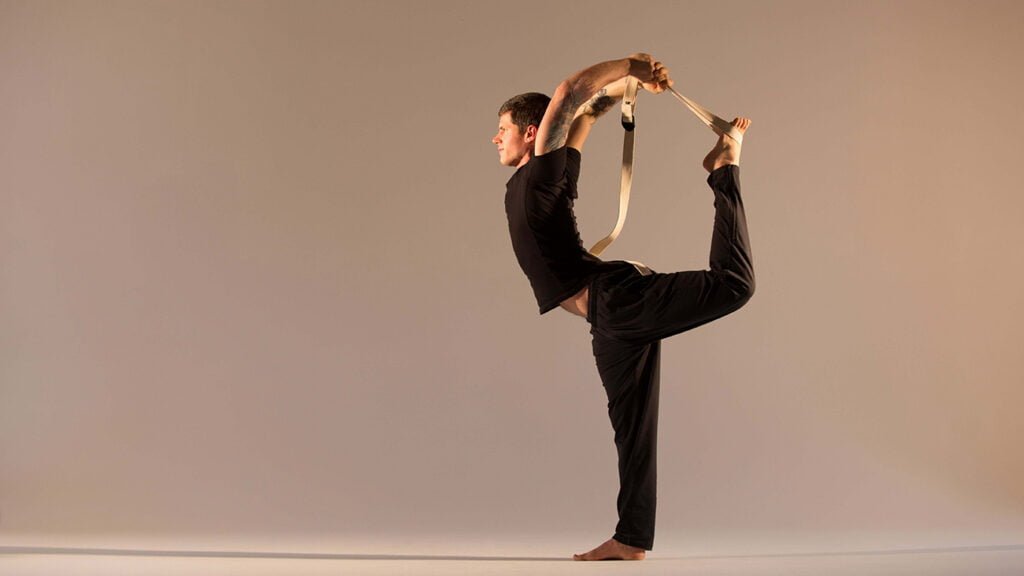Natarajasana Yoga: Embodying Grace and Strength with Dancer’s Pose
Table of Contents
Introduction
Natarajasana Yoga, commonly known as Dancer’s Pose, is a captivating and dynamic yoga posture that embodies grace, strength, and poise. Derived from the Sanskrit words “nata” (meaning dancer) and “raja” (meaning king), Natarajasana invites us to emulate the majestic and fluid movements of a dancer, both physically and metaphorically.
In this article, we will explore the steps, benefits, variations, and precautions associated with Natarajasana, empowering you to incorporate this elegant pose into your yoga practice.
How to Perform Natarajasana Yoga
To practice Natarajasana Yoga, follow these step-by-step instructions:
Step 1: Begin in a standing position with your feet hip-width apart and your arms at your sides.
Step 2: Shift your weight onto your left foot and ground firmly into the mat.
Step 3: Bend your right knee and reach back with your right hand to grasp the inside of your right foot or ankle.
Step 4: Extend your left arm forward at shoulder height, parallel to the ground.
Step 5: On an inhalation, begin to kick your right foot into your hand while simultaneously extending your left arm forward.
Step 6: Maintain a steady gaze on a fixed point in front of you to help with balance.
Step 7: Continue to kick and reach until you find a comfortable stretch in the front of your body while keeping your standing leg strong and engaged.
Step 8: Hold the pose for 30 seconds to a minute, focusing on your breath and maintaining your balance.
Step 9: Slowly release the pose by releasing your foot and bringing your right leg back to the ground.
Step 10: Repeat the same steps on the opposite side.
Benefits of Natarajasana Yoga
Regular practice of Natarajasana Yoga offers a multitude of physical and mental benefits, including:
a. Improved Balance and Concentration: The one-legged balancing aspect of Dancer’s Pose challenges your balance and enhances your focus and concentration.
b. Increased Flexibility: Natarajasana Yoga stretches the shoulders, chest, thighs, and hip flexors, promoting increased flexibility and range of motion in these areas.
c. Strengthened Legs and Core: The standing leg in Dancer’s Pose becomes stronger as it supports the body’s weight, while the core muscles engage to maintain balance and stability.
d. Improved Posture and Spinal Alignment: This pose opens the chest, stretches the front body, and encourages proper spinal alignment, thereby improving posture and reducing slouching.
e. Enhanced Mind-Body Connection: The mindful execution of Natarajasana cultivates a deep mind-body connection, promoting a sense of harmony and awareness within oneself.
f. Boosted Confidence and Self-expression: Practicing Dancer’s Pose can help boost self-confidence and self-expression, as it encourages you to embrace your body’s natural grace and strength.

Variations of Natarajasana Yoga
Explore these variations of Natarajasana Yoga to add variety and challenge to your practice:
a. Half Dancer’s Pose: Begin in a standing position and bend one knee, bringing the heel toward the glutes. Reach back with the same-side hand and grasp the inside of the foot or ankle. Gently kick the foot into the hand while maintaining balance.
b. Standing Dancer’s Pose with Wall Support: Stand next to a wall and use it for support while performing the pose. This variation is helpful for beginners or those seeking extra stability.
c. Revolved Dancer’s Pose: From the full expression of Natarajasana, twist the torso toward the bent leg, bringing the opposite elbow to the outside of the knee. This variation adds a spinal twist, offering additional benefits for spinal mobility and digestion.
Precautions and Contraindications
While Natarajasana Yoga is generally safe for most practitioners, it’s important to consider the following precautions:
a. Avoid this pose if you have recent or chronic ankle, knee, or hip injuries. If you have any concerns or limitations, consult with a healthcare professional or an experienced yoga instructor before attempting Dancer’s Pose.
b. If you have high or low blood pressure, practice Natarajasana with caution. Avoid raising the arm overhead if it causes discomfort or dizziness.
c. Pregnant women should modify or avoid Dancer’s Pose, especially as the belly grows. Modify the pose by using a strap or towel to hold the foot or practice a standing variation with the support of a wall.
Conclusion
Natarajasana Yoga, the Dancer’s Pose, invites you to embody grace, strength, and balance in your yoga practice. Through regular practice of this elegant pose, you can experience improved balance, increased flexibility, and enhanced mind-body connection. Approach Natarajasana with mindfulness and patience, respecting your body’s limits and honoring its unique journey.
As you emulate the poise and fluidity of a dancer, allow the benefits of this pose to unfold, nurturing your body, mind, and spirit. Embrace the transformative power of Natarajasana and incorporate it into your yoga practice, as you gracefully navigate life’s challenges with strength and beauty.





